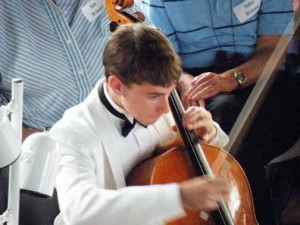A Look Inside a Composer’s Brain: The Composition of “Fanfare for a Summer Evening”
How does a composer write a piece? The question is simple, but its answer is complex. To a person who hasn’t dabbled in the noble art of composition, I could imagine the task seeming to be quite daunting; with no other tools at one’s disposal but a piano, pen, and manuscript paper, how can one find the inspiration within oneself to conjure musical ideas that not only adhere to proper theoretical conventions but emulate a definitive character as well? How does one decide which instruments to write for, which ones play the melody and which ones accompany? How soft or loud are they? What mood? Tone? Expression? And above all, how does one ultimately come up with a piece that is not only satisfactory in all of these areas, but relatable to its audience as well?
Although I’ve written a number of works over the years, I still found myself asking these same questions as I sat down in early May to begin composing, “Fanfare for a Summer Evening” for Midsummers’ opening night gala. All I had to go on was the type of piece I had agreed on with Jim–a fanfare for string quartet–and the title I had come up with back in April when Kathleen had needed it for the “Sneak Peak” brochure (due to the stringent demands on my free time that came with the end of my senior year of college, I was unable to start the piece until after that brochure had actually gone out–I must say that seeing my yet-to-be-written composition advertised in attractive cursive lettering certainly motivated me to get going!). I knew that I wanted to write a piece that was simple yet substantial, one that was clearly a fanfare but also had some less boisterous moments, and most importantly, one that embodied the spirit and purpose of the occasion: a prelude to five weeks of concerts and celebration in a Door Peninsula exuding the essence of midsummer. So, after my senior recital was over on May 6th and I was at last able to direct my attention to other matters, I began to brainstorm musical ideas that might be suitable for such a work.
For me, much of the compositional process takes place entirely in my head; while I’m usually able to come up with something after fooling around on a piano to the extent that my mediocre keyboard skills will allow, I’ve always found that my best ideas come from imagining music while I’m going about my day-to-day activities. In fact, most of the fanfare’s main melodies were “written” while I walked around the streets of Boston in the weeks preceding my graduation from the New England Conservatory, feeling the rhythm of my feet on the cobbled sidewalks and taking in the sights and sounds of the bustling city around me. I find my inspiration in my surroundings because that is where music comes from–everything we hear has a pitch, and every movement we feel has a rhythm. Yet, as I trod the familiar New England roads, I was mentally transporting myself halfway across the country to a very different place: the relaxed, peaceful world of Door County. In my mind’s eye, I saw an orange-red sun sinking into the sparkling waters of Eagle Harbor, its dying rays gleaming on the white rooftops of Ephraim, ending the day with a royal majesty. You don’t see sunsets like that in Boston.
Of course, composing the melodies of a piece is only half the battle; when writing for four instruments, only one or two will typically have the theme, and the composer has to figure out what to give the others. With me, this is always a process of trial and error. I can figure out the harmonies I want after experimenting with various options on a keyboard, but deciding which instrument gets which note in the harmony is a more difficult task, as several factors must be taken into consideration. Each instrument in a quartet has a different range and timbre, and the capabilities of each instrument often dictate what notes they will play. In classical string quartet writing, the cello will typically have the lowest note in a chord, given its extensive range, while the viola and second violin will have the middle and top notes, respectively, and the first violin will either double somebody or have another note in the key that works with the accompanying chord. Of course, this is not always the case. Without going too far into what would undoubtedly be a boring music theory lesson, I’ll just say that if done correctly, the instruments do not always have a certain place in a particular chord as long as it makes sense with the chords preceding it and following it. Basically, one needs to avoid awkward leaps between notes in a given line, so it doesn’t sound as though the accompaniment is jumping all over the place. Much of “Fanfare” is written in rather strict voice-leading, meaning that I try very hard to make the underlying harmony less noticeable than the melody on top (i.e. I wouldn’t want someone to be distracted by the viola line when the violin is the voice I want to come out.) This whole process takes a great amount of time. Often, I would spend a couple of hours on what would ultimately turn out to be about thirty seconds of music. This is partly because I don’t compose all that often, so I have considerably less experience in knowing “what works” without having to try a variety of options first, but also because, like in any work of art, it takes a long time to get the product one really wants.
However, it didn’t always happen like this. Sometimes, I would get struck by inspiration after an hour or two working out tedious voice leading at the keyboard and whatever came out of the piano ended up being the finished result. (I was fortunate to be using a composition computer software that instantly transcribed whatever I played on an electric piano, so I didn’t have to constantly notate what I was coming up with.) One section of “Fanfare” that is purely a “first draft” inspiration is the prominent viola solo during the middle section. I had just worked out the melody in the violin and wanted an “echo” of it in another instrument, and I thought to myself, “Why not the viola?” I played it into the computer, came up with with some basic accompaniment, and never changed it. Ironically, it ended up being my favorite part of the piece, and gave my brother Anthony, who was the violist in the concert, a chance to shine. It’s funny how one can spend hours trying to come up with something good, and then every now and then something just works. I would surmise it’s because one gradually assumes a certain “creative” mindset while composing, in which inhibitions are let go and a certain impulsiveness takes over. Of course, these “impulses” often fail miserably. About 90% of the time, this happens to me, and I hurriedly delete my pathetic creations before another human can come along and hear them. But it’s those moments that happen 10% of the time that make such compositional risk-taking really worth it.
The composition of the work followed a rather jagged timeline; I began it on May 10th, composed daily through the 16th, took about a week off to graduate, move out of my apartment and drive back to Chicago, and then finished the rest of the piece on May 25th. On the 26th and 27th, I added in dynamics and tempo markings, and on the evening of the 27th my family played it through for the first time. I had already heard an audio version of the piece produced by the computer software, but hearing it live was of course a completely different experience. What had been going through my mind for the last two weeks had finally come to life as living, breathing music, ringing in the air around with me with a youthful vitality. Such an experience makes all of the tedious harmony work and long hours of craning one’s neck in front of a computer screen worth it. I only regretted that I would be unable to be present on opening night to hear its premiere–my whole rationale for writing the piece stemmed from the fact that I was in attendance at the National Cello Institute at the University of Wisconsin-Madison on June 8th and therefore unable to be up in Door County to play with my family, so writing the work was my way of being there “in spirit”–but I was excited to hear from my family members of the enthusiastic reception that the piece received, and am looking forward to seeing the video that was taken of the performance.
I could probably write a whole book about the compositional process–in fact, I could even provide an annotated version of “Fanfare” with explanations under each measure as to why I made the musical decisions that I did–but in the interest of space and your undoubtedly waning attention span (which probably took a hit after the music theory paragraph), I’ll bring this article to a close. Before I do, however, I wish to intimate one last lesson that I have learned through serving music in my capacity as a composer. Just the other night, I had the pleasure of hearing the Brahms F minor Piano Quintet performed by Midsummers’ musicians at the Ephraim Moravian Church, and from the opening bars found myself immersed in the music (as anyone sitting in the same pew as me can attest–I had a difficult time sitting still in some of the more exciting parts). However, as I listened I realized that while I was focused on the rich sonority emanating from the group, their facial expressions, and their movements, I wasn’t really thinking about Brahms, although he was the sole reason we were all there. As the slow movement opened, I imagined the bearded German master sitting dutifully at a piano, painstakingly figuring out chord changes, harmony, and melodic lines. I could really sympathize with him, I realized, even though I’m sure he could have written something like my “Fanfare” in a heartbeat (on the figurative composers’ ladder, he’s beyond the top rung and I’m barely grasping the bottom one). But it caused me to ponder: how much to do we really think about composers? When we watch a movie, we all come out praising the actors and actresses, but we rarely give a thought to the screenwriter; often times, we don’t even know who he or she is. Of course, the actors–and the musicians, in the case of our musical context–are vitally important, but we mustn’t ignore the real creative force behind the musical experience that we’re having–a person of the past, pouring out his soul into notated sound, hoping that some audience then, or in the distant future, can grasp the thoughts and emotions he is attempting to emulate through music. It is my belief that having this perspective truly enriches our whole experience as listeners. We sit not only in awe of the music, but of the fact that humans are capable of creating such an awe-inducing entity. Such is perhaps the most valuable thing I have gained from being a composer, and for it I am deeply grateful.

